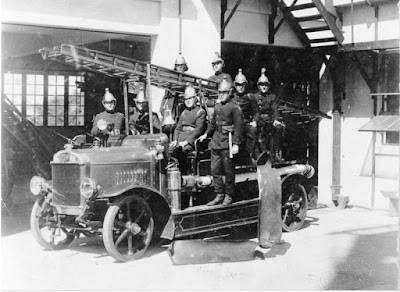By the mid 1920s, the
Townsville Fire Brigade, which had served the city since 1884, had outgrown its
home next to the Town Hall in Flinders Street.
 |
| Firemen at the Central Fire Station, Townsville. Photo: Townsville City Libraries Local History Collection. |
A new fire station at
the intersection of Stokes and Walker Streets officially opened on 24 July 1926,
and at the time it was considered to be one of the most modern fire stations in
the state.
Built at a cost of
£10,500, the Townsville Daily Bulletin
reported that the new station was “fully equipped with a fire-fighting plant
which should enable the permanent brigade to give the best results.”
The new station
boasted an engine-room that could accommodate four fire appliances and every
care was taken to provide for the firefighters as well, with the inclusion of a
gymnasium on site.
The drill yard at the
back of the station contained a 54 ft. tall iron tower brought from the old
station in Flinders Street and re-erected. A wooden face was built on the side of the
tower that faced Walker Street, which represented a four-storey
building. This was used to train the firefighters in hook ladder, jumping and
life-saving drills. It also doubled as a
hose-drying tower.
 |
| New Fire Station, open to the public, corner Walker and Stokes Streets, 1926. Photo: Jefferey Collection, CityLibraries Townsville Local History Collection. |
In a city that was
often plagued by building fires, having an efficient fire brigade was crucial
to the safety of citizens. But the
ability to fight fires effectively was sometimes less about having trained
personnel and state-of-the-art equipment, and more about having sufficient
water to actually fight the fires.
One disastrous fire
that might have been extinguished sooner if a reliable water supply had been
available was the fire at the Bulletin
office in October 1912.
When fire broke out
in the basement of the building in a reel of paper, the fire brigade were
swiftly on the scene. However, when they
arrived they found that there was no water to fight the fire as the city
council had switched off the water overnight in order to conserve the city’s
precious water reserves.
The engineer at the Waterworks
was notified, but it was 15 minutes before the water was turned on and then it
took another 5 minutes to reach full pressure.
The report on the
fire in the Cairns Post was scathing,
pointing to the brigade’s outdated equipment.
“When the alarm was
given, the Fire Brigade were quickly out, but owing to their antediluvian appliances
they were unable to make the slightest impression on the blaze which within
about twenty minutes had a complete hold of the building.”
But a lack of water
and antiquated equipment wasn’t the only problem. The brigade appears to have
been somewhat lacking in overall organisation as well and at least six of the
firefighters who attended the fire had no helmets. Apparently in their rush to get to the fire,
they had left their helmets at home.
Two of the firefighters
without helmets were injured, one seriously. J.H. Foley was knocked
unconscious when part of the building collapsed on top of him and he was taken
to hospital in a critical condition.
 |
| Townsville Central Fire Station, no date. Photo: CityLibraries Townsville Local History Collection. |


